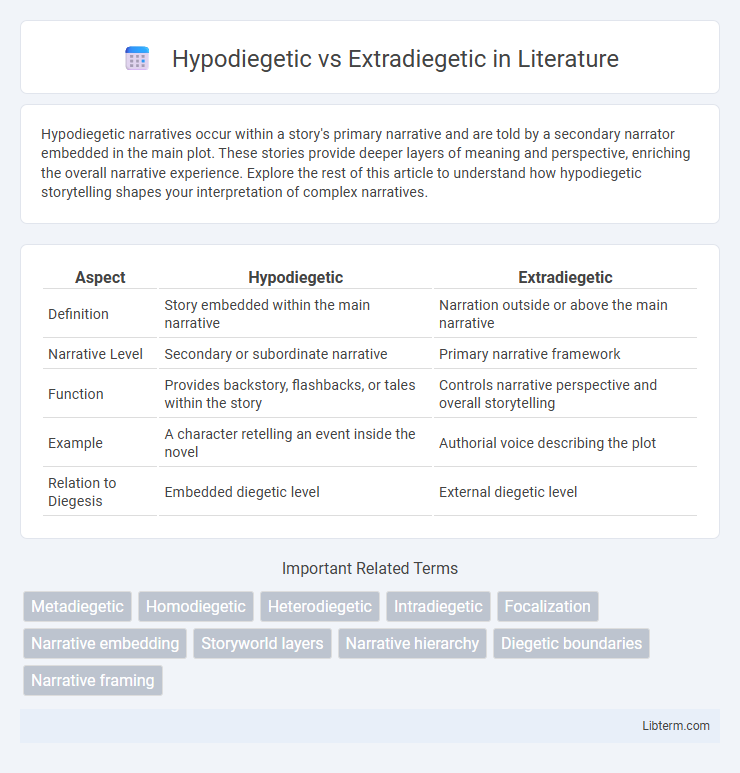Hypodiegetic narratives occur within a story's primary narrative and are told by a secondary narrator embedded in the main plot. These stories provide deeper layers of meaning and perspective, enriching the overall narrative experience. Explore the rest of this article to understand how hypodiegetic storytelling shapes your interpretation of complex narratives.
Table of Comparison
| Aspect | Hypodiegetic | Extradiegetic |
|---|---|---|
| Definition | Story embedded within the main narrative | Narration outside or above the main narrative |
| Narrative Level | Secondary or subordinate narrative | Primary narrative framework |
| Function | Provides backstory, flashbacks, or tales within the story | Controls narrative perspective and overall storytelling |
| Example | A character retelling an event inside the novel | Authorial voice describing the plot |
| Relation to Diegesis | Embedded diegetic level | External diegetic level |
Introduction to Narrative Levels
Hypodiegetic narratives occur within the primary story world and involve embedded or secondary narratives told by characters inside the main diegesis. Extradiegetic narratives stand outside the story world and are typically delivered by an external narrator who is not part of the narrative events. Understanding these narrative levels is essential for analyzing how stories are structured and how different layers of storytelling influence audience perception.
Defining Hypodiegetic Narration
Hypodiegetic narration occurs when a story is told by a narrator who exists within the narrative world, often as a character recounting events they directly experience or observe, creating a layer of storytelling embedded in the story itself. This contrasts with extradiegetic narration, where the narrator exists outside the story's diegesis, offering an external perspective without participating in the events. Hypodiegetic narration enhances narrative depth by providing intimate, subjective viewpoints, enriching the audience's engagement with the characters and plot.
Understanding Extradiegetic Narration
Extradiegetic narration occurs when the narrator exists outside the story world, providing an external perspective that is not limited by the characters' knowledge or experiences. This type of narration often offers a broader, more objective view, allowing insights into multiple characters and events beyond the immediate narrative. Understanding extradiegetic narration is crucial for analyzing how authors manipulate narrative layers to guide reader interpretation and control the flow of information.
Key Differences Between Hypodiegetic and Extradiegetic
Hypodiegetic narrators exist within the story world, often as characters or participants, providing a perspective grounded in the narrative's internal events. Extradiegetic narrators stand outside the story world, offering an external viewpoint and often possessing omniscient knowledge beyond the characters' understanding. The key difference lies in their narrative positioning: hypodiegetic narration unfolds from within the diegesis, while extradiegetic narration occurs from an objective, external stance.
Examples of Hypodiegetic Narratives
Hypodiegetic narratives occur within the primary story world and are often stories told by characters to other characters, such as the campfire tales in Mary Shelley's "Frankenstein" or the embedded narratives in "The Canterbury Tales" by Geoffrey Chaucer. These secondary stories create layers of storytelling that deepen character development and thematic complexity, allowing readers to explore multiple perspectives within the same diegetic level. Examples also include the dreams and flashbacks in Vladimir Nabokov's "Lolita," which function as hypodiegetic narratives revealing inner conflicts and backstory.
Examples of Extradiegetic Narratives
Extradiegetic narratives occur outside the story world, with the narrator existing in a separate narrative level from the characters, often providing an external perspective or commentary. Classic examples include the omniscient narrator in Homer's "The Iliad," where the storyteller stands outside the events, and the narrator in Jane Austen's "Pride and Prejudice," who offers insights without being part of the story itself. Modern films like "The Grand Budapest Hotel" use an extradiegetic narrator to frame the main narrative while remaining distinct from the fictional reality.
The Role of the Narrator in Hypodiegetic vs Extradiegetic Contexts
In hypodiegetic narratives, the narrator is embedded within the story world, often as a character who directly influences the plot and provides an intimate, subjective perspective. Extradiegetic narrators exist outside the story world, offering an authoritative, omniscient viewpoint that guides the audience through the narrative without personal involvement. The role of the narrator in hypodiegetic contexts emphasizes internal storytelling dynamics, while extradiegetic narrators maintain a detached, overarching control of the narrative structure.
Impact on Story Structure and Reader Perception
Hypodiegetic and extradiegetic narrators significantly impact story structure and reader perception by defining the narrative distance and focalization. Hypodiegetic narration, occurring within the story world, often creates intimacy and reliability, shaping readers' engagement with characters and events through an insider's perspective. Extradiegetic narration, positioned outside the story world, typically offers broader context or commentary, influencing readers' understanding by providing an authoritative or omniscient viewpoint that governs the overall interpretation of the narrative.
Analyzing Literary Works Using Narrative Levels
Hypodiegetic narrators exist within the story world they recount, offering subjective perspectives that deepen character development and thematic complexity in literary works. Extradiegetic narrators operate outside the story world, presenting omniscient or reliable accounts that shape readers' understanding through broader narrative control. Analyzing narrative levels through hypodiegetic and extradiegetic distinctions reveals how authors manipulate focalization and narrative authority to influence interpretation and emotional engagement.
Conclusion: Significance of Narrative Distinctions
Hypodiegetic and extradiegetic narrative levels crucially shape audience engagement by defining the boundary between story immersion and external commentary. Hypodiegetic narratives unfold within the story world, offering direct access to characters' experiences, while extradiegetic narrators provide overarching perspectives outside the narrative, guiding interpretation and thematic framing. Understanding these distinctions enhances critical analysis of narrative structure, deepening insight into how stories construct meaning and influence reader reception.
Hypodiegetic Infographic

 libterm.com
libterm.com